(Static -vrs- Dynamic)
9b
~ The Study of Threes ~
http://threesology.org
Visitors as of 2/27/2021

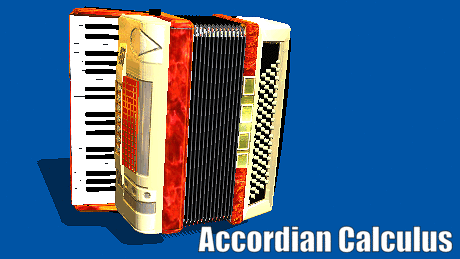
Yes, while we can get involved with a philosophical chess match of infinitesimal (infinitely small) definitions, so-to-speak, about whether or not calculus is stationary or in motion, the point to be made is that calculus is much like the current state of DNA... with its recurring triplet code that does not appear to be evolving (that is it is apparently static... non-moving in an evolutionary sense), (and, again, let us say it is therefore stationary in this sense), and suggests that it is being subjected to constraints which create a condition of conservation. However, don't misinterpret what I am saying. While I am claiming that Calculus is stationary, this static state appears to be the result of a forced conservation of its ability to grow beyond it current functionality. It's geometric equivalent is that of a line... hence, we see it in line-ar equations. Yet, the trend of development as seen in multiple other instances is to proceed from the linear into a circular and then into a triangular disposition. Calculus is not doing this.
Whereas we have linear equations to deal with linear, circular and triangular observations and forms, we do not have circular nor triangular equations to deal with circles and triangles. Like Algebra, Geometry and Calculus that were at one time absent from even the slightest consideration of development until much later on in human history from the basic forms of number concepts attendant with language equivalent words; mathematicians have not developed a sense of what could be possibly meant by a "circular" (spherical) or "triangular" equation. Though there are those who have pursued The Remarkable Trinities in Mathematics such as Vladimir Igorevich Arnold, and the Triplets and Triads in Mathematic by Sir William Roland Hamilton; we can also claim the interest in circles started long ago and may be viewed in terms of a question such as: Why Humans Are Obsessed With Circles, (According To Science).
Granted that may people have paid witness to what appears to be an obsession with lines, circles and triangles with which they add other geometrical forms, but such observers do not then take their observations and collate them into a representative idea concerning the possibility that they may represent a developmental scenario of human thinking, such that one form preceded another after which another can be plotted along a graph. For example, a linear- circular- triangular sequence of events like a linear-like strand of molecular materials developing into a circular-like composite from which emerges a polymorphous conglomeration we define as a life-form, but do not routinely describe such life-forms as being triangular shaped, though some of them go on to have triangular- shaped body parts, functionalities and may even come to construct triangular-like structures to live in, worship, use as a tool, etc...
In a third analogy, what can cite those who claim that Capitalism is a robust villain of humanity traveling from place to place selling its wares, but overlook that it is actually a stationary tool... like many tools; which are used by those who wish to affect deeds according to personal greed that very often cause a great deal of financial hardship for many. In other words, despite all those who claim that Capitalism is active sprawling vine of evil growth causing so much inequality, it is actually like so many other tools which remain in a toolbox to be used by a particular person, or religion, or business, or government for their idea of good, for ill, or for creating more problems due to ulterior motives which begin to blossom, even though the initial intention was meant to be socially supportive.
The following is a quote I extracted from another "textualarity" (text with alternative [non-mathematics oriented] commentary), but has application to mathematics, if we view mathematics as a symbolic representation of a life form and take into account of the fact that the person to whom the quote is attributed, was a mathematician:
"The manifestations of life— are so diverse that they must contain a large element of the accidental. And yet the nature of life is so uniform that it must be constrained by many necessities." J. Bronowski, 1976. The Ascent of Man, BBC, p. 291. ertebrate hearing: Origin, evolution and functions by Geoffrey A. Manley
Jacob Bronowski (18 January 1908 – 22 August 1974) was a Polish-British mathematician and historian. He is best known for developing a humanistic approach to science, and as the presenter and writer of the thirteen—part 1973 BBC television documentary series, and accompanying book, The Ascent of Man, which led to his regard as "one of the world's most celebrated intellectuals."
The ascent of man episode 1 on youtube.
While some readers may describe the view that looking upon Mathematics as a living creature is an exercise in illusory projection or anthropomorphism, let us accept the need for a broad-based latitude and permit the analogy, since it is a useful concept that I will address from the vantage points of different subjects; one of which is the physiology of hearing, since the language of mathematics is a living tongue articulated within an aural landscape of tradition that is so introverted at the moment it cannot see the change in the season(s) of human consciousness. Calculus is like an animal (or person) that has been locked up for so long, it is difficult for them to have a realization for development outside the cage. The cage is representative of the constraint I see occurring not only with Calculus, but all mathematics. Mathematics, like all other subjects is a tool that is "tweeked" from time to time as an adaptation to the presence of incrementally deteriorating environmental constraints which demand compliance for the purpose of maintaining some measure of intellectual comparability to the rate and kind of deterioration so as to assert the change as a necessity of survival and thus must be considered an inviolable Natural Law.
The "Broad-based latitude" approach I am using can be summed up as an exercise in generality ... a concept well-fitted to the usage of Pure Mathematics in which Calculus can be said to integrate both pure and applied mathematical inquiry because, as I see it, it is a fence "straddler" since it can move in either direction depending on context:
Generality and AbstractionOne central concept in pure mathematics is the idea of generality; pure mathematics often exhibits a trend towards increased generality. Uses and advantages of generality include the following:
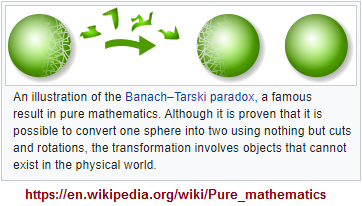 |
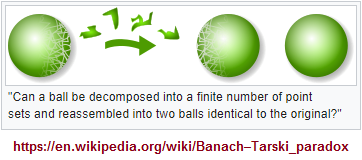 |
- Generalizing theorems or mathematical structures can lead to deeper understanding of the original theorems or structures.
- Generality can simplify the presentation of material, resulting in shorter proofs or arguments that are easier to follow.
- One can use generality to avoid duplication of effort, proving a general result instead of having to prove separate cases independently, or using results from other areas of mathematics.
- Generality can facilitate connections between different branches of mathematics. Category theory is one area of mathematics dedicated to exploring this commonality of structure as it plays out in some areas of math.
Pure Mathematics
In summary, while some mathematicians think only to make mix. match, and alter comparisons of ideas within mathematics... as if mathematics alone is the repository of all great thinking to ever be discovered... if only one can arrange the present models of mathematics in the appropriate way to uncover the supposed hidden truths... like priests who think their respective religious doctrines hold the key to all questions; we need to upset this apple cart by remarking that enhanced understanding involves the mixing and matching and manipulation of all subject matter... including the adopting of a new mathematical language from its current valuations which give the impression of being an ancient tongue with a limited vocabulary based on the limited perceptions of those who are involved in the production of creating new words and/or symbols in mathematics.
Note: in the foregoing and right-hand images referred to as the Banach-Tarski paradox, it is extremely easy to visualize creating two or more spheres out of one by using bits and pieces or even whole sections so long as one is permitted to use abstract rules-of-thumb which are not made-to-order which one must abide by like an instruction sheet which paradoxes are usually framed as if assembly or disassembly must... without alteration, take place within constraints. Analogously, different card and board game variations can be played outside the rules offered in a pamphlet or on one of the inside covers of the container housing the particular pieces of the game. Paradoxes are usually framed in a "must to this" "you must view it in this manner" paradigm or you will be accused of not participating in the game or construct in the "right way".
As with many subjects, mathematics provides us with a spectrum of different approaches towards observing, translating and give expression to those observations. However, just like the electro-magnetic spectrum whose range is said to be unlimited at two opposing ends, the attributes of humans' ability to interact with the world is especially limited. It can only use a fraction of the available degrees or frequencies found in the spectrum. Hence, while it is uncommon for us to think of a subject such as mathematics as belonging to a given point on a spectrum, it is not too difficult to think in such terms when we take into account that brain activity resides in a given spectrum of bio-electrical activity labeled in terms of Alpha, Beta, Delta and Gamma waves, which therefore at least suggests that mathematically related brain activity does have a characteristic spectrum in which it exists:
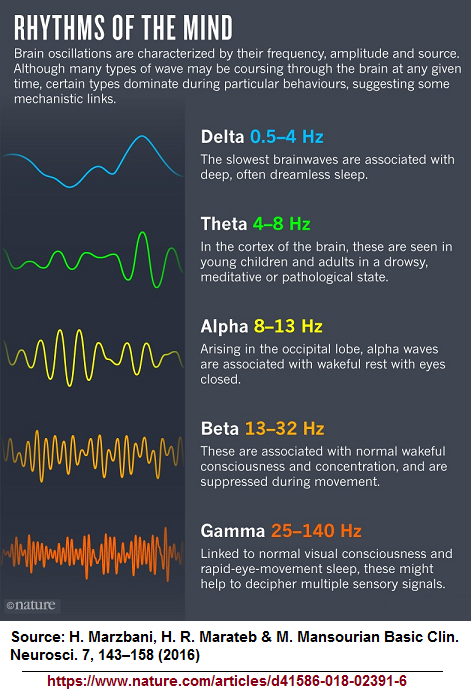
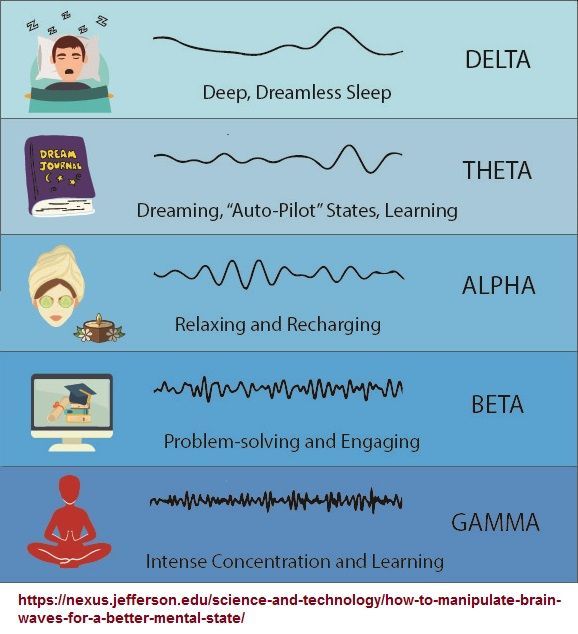
There are 5 major categories of brain waves, each associated with different mental functions:
- Delta Waves (0.5-3 Hz): slow, loud brain waves associated with dreamless sleep, deep meditation, and healing.
- Theta Waves (3-8 Hz): brain waves related to dreaming, spatial navigation, intuition, meditation, memory formation, alertness, creativity, and subconscious thinking.
- Alpha Waves (8-12 Hz): the quiet resting state of the conscious brain, associated with working memory, calculations, and the coordination of thoughts.
- Beta Waves (12-38 Hz): associated with active problem solving, complex and effortful thinking, motor control, high anxiety, excitement, and judgment.
- Gamma Waves (38-100 Hz): the least-understood brain waves, believed to be involved in the integration of thought processes by linking information from different parts of the brain, active consciousness and self-awareness, peak cognitive functioning, and possibly spirituality.
It is important to remember that at any given time, there are varying levels of each of these brainwave patterns occurring in our brain.
In n effort to attempt an alteration of a mental state, an artificialized auditory input (as opposed to some other sensory channel) is used. It is of importance to note that the two-word phrase "binaural beat" actually refers to three references. In other words, the word should be "trinaural beat", but two-patterned predominant orientations focus on a "two-patterned preference", thereby creating a culture of dichotomization that is evident in several subjects, one of which is mathematics... to be highlighted by a separate web-page which denotes the very many usage of dichotomies. It should also be noted that many of the ideas being related to brain waves was explored decades ago, and the reemergence of interest by a younger generation of researchers unaware of previous explorations, think they have discovered something new and original. For example, the use of strobe-lights to effect changes in patients with mental disorders related to brain wave activity. For those who danced with strobe-light effects and beating music during the disco (dancing) era, many people noted a changed orientation in themselves for short periods of time, but never pursued extensive research with the idea of applying their personal observations to alleviating those people who had developed on-going distortions of brain wave activity which were called one or another type of mental illness... and in addition, very few thinkers publicly describe their considerations when they muse upon the possibility that all types of subject interests are types of brain wave distortions that are defined as normalcy because the majority of people share in the same brain wave functionality.
Binaural Beats Meditation: 'Binaural beats meditation' has become a common term for listening to binaural beats music. This may seem a little confusing because not all binaural beats music is designed for meditation and relaxation.
However, there are three main reasons as to why this name has been adopted:
In a similar way to meditation, a lot of binaural beats music is designed to entrain the brain in a similar way to that of meditation, which is referred to as mindful awareness, or entirely in the present moment.
Generally speaking, binaural beats music is accompanied by ambient, relaxing music, which is usually quite similar to the sound design used in meditation music. As in meditation practice, when listening to binaural beats, some people choose to sit in the traditional lotus meditation position because it is conducive to attaining a relaxed, centered state of mind. This state is also conducive to entraining the mind. Rather Binaural Beats is perceived as an auditory beat and theoretically is being used coach certain brain rhythms from what is called the frequency-following response (the tendency for the brain to resonate at the frequency of an external stimulus).
Notice that not once did the author of the above reference make the note to another item as the following excerpt does, yet it too falls short of explicitly saying the word three or third:
When you hear two tones, one in each ear, that are slightly different in frequency, your brain processes a beat at the difference of the frequencies. This is called a binaural beat. Do Binaural Beats have health benefits? (What are Binaural Beats?)
In the following selection about Binaural Beats synchronize brain activity, (don't affect mood), the author claims the so-called third beat is an illusion, though from a mathematics point of view, the discussion involving a 1- 2- and 3 beat occasion should ring a bell since it reflects the developmental scenario of primitive peoples learning a sense of number-to-word association. In other words, it is a sense of enumeration which is being encountered in a context removed from mathematics, which makes the analogy difficult to see as a mental relationship. Those participating in the discussion of mono-aural, bi-naural, tri-naural considerations don't see their efforts as another re-formulation of an early counting theme. The human brain is rehearsing a very old brain activity in a different context. While the context is different, not the underlying brain activity. The basic counting system is being revisited and not visiting a new type of mental functioning. The human brain is repeating itself and not evolving unto a "higher" realm of understanding, as if it is being forcefully bound to a conservation... a deliberate limitation.
Binaural beats are an auditory illusion caused by listening to two tones of slightly different frequency, one in each ear. The difference in frequencies creates the illusion of a third sound -- a rhythmic beat. Neurons throughout the brain begin to send electrical messages at the same rate as the imaginary beat. Many unsupported claims surround binaural beats, including that listening to them decreases anxiety, increases focus, and improves mood.
Orozco Perez et al. played binaural and monoaural beats to healthy adults and measured their brain activity with electroencephalography. Monoaural beats don't rely on the illusion to create the beats because they consist of edited audio tracks of the two different tones together. Both ears hear all three sounds. Brain activity synchronized with both types of beats, but the effect was stronger with monoaural beats. Neither type of beat affected mood. When the binaural beat played, far apart brain areas synchronized with each other at a different frequency than the beat. This may be how binaural beats improve memory and focus.
- Wikipedia: Flicker-Fusion threshold
- Humans perceive flicker artifacts at 500 Hz by James Davis, Yi-Hsuan Hsieh, and Hung-Chi Lee
- Critical flicker frequency responses in visual cortex
When I was in elementary school, I used to complain about the flickering overhead lights, but no one believed me because they couldn't detect them. I used to also complain about the flickering television screen, but again no one believed me. They either couldn't see it or agreed with the view of some teacher so as to not be looked upon as "weird". So when I tell you I see a star that is flickering funny, you should give me the benefit of the doubt. However, I am not troubled by flickering fire-place or candle-light. Indeed, it was my 'ability' to see flickering rates where others couldn't which led me to viewing the Sun's 3- patterned strobe-light effect as the Earth rotated at accelerated speeds billion of years ago. I could stand outside and see the Early Earth spinning much faster than it is today against a Sun which created a three-patterned (dawn- noon- dusk) "imprint" on biological development. You have got to be able to see the Earth spinning at a rate in which the length of a day was in the 1 to 2 hour range and then over-time increased as the environment went from a reduced oxygen event to one where increasing levels of oxygen was poison to many of then living life forms... to be followed by life forms which could utilize oxygen.
As this page progresses, though much of it may appear to be in a "thrown together arrangement" of seemingly disparate materials from different subjects which are being shoe-horned into a narrative by correlations that are either taken for granted or else wise dismissed as being irrelevant when standing on their own in their separate contexts; let me nonetheless make a point about the usage of the words "linear- circular- triangular" which appears as a statement suggesting a cognitive progression. Though some readers automatically view such words as representing generalities, others may be pressed hard to construct some definitively perfect looking (or acting) line, circle and triangle. In other words, is a line a line though the width is 3cm 3 mm, 3 inches, 3 feet, or 3 miles wide? Likewise, at what point to we say a circle is no longer a circle. For example, if we flatten one side of a circle is it still a circle or has it become something else simply because we have readily available label for such a construction? If we had no word such as "square", could we thus call a sphere with four flattened edges a circle as well? The same goes for the word "triangle". At what point of distortion do we claim it as no longer being a triangle?
When I use the suffix "ar" after line (line-ar), circle and triangle (since each word continently supplies an "e"), I am referring to the suffix "ish". Whereas one may be excused to use the word "roundish" to indicate a circular-like object or instance, the usage of the "ish" suffix for the words "line" (lineish or linish) and "triangle" (triangleish or trianglish), ring in the ears with too much unfamiliarity that they might cause an interruption in thought processing because a given reader is expecting the usage of conventional language when confronted by a serious topic as is suggested by the title. Where as "roundish" is an acceptable alternative for circle-like, the English language does not readily afford us with similarly useful terms when describing a line-like or triangle-like object or instance. Hence, I have chosen to use the words grouped as "linear- circular- triangular" to mean a generality of design in order that other three-patterned examples from other subjects can be correlated, without being faced with someone who wants to use the words "line- circle- triangle" in a strict sense, without any margin for accommodating any imperfection of the ideas which come to their mind when seeing the words being used. Some degree of latitude must be given.
Let us take an example from the so-called real world. If we are told we must use a flat stone to skip across the surface of a body of water, we are given into the usage of a generality and will try multiple variations of what may be a useful flat surface. The same goes for when we seek some acceptable round stone to propel from a sling or sling shot. Whereas in the past humans may have used linear sticks or bones as a readily available preference, they eventually moved on to using "roundish" stones and eventually developing items involving a triangular shape such as in knife, spear and arrow points. Whereas we might well come across one or several rocks that might serve a preferred definition of linear-like, circular-like and triangular-like, we allow ourselves some latitude because the so-called real world is not typically accommodating in providing us with our notions of what we might think is meant by a line, a circle and a triangle, though the (present day) usage of such geometries did not evolve as penultimate declarations of a human-devised truth until some time later in human civilization. Hence, let us not forget that the idea of lines, circles and triangles are human constructs, even though we can cite examples of these forms in nature. We humans made them up, at least in terms of how we use and make reference to them.
Similarly, when I claim that linear-like trees are natural at lower... sea-level environments and that as we move towards higher elevations we pay witness to roundish (robust foliage) trees followed by a predominance of triangular trees at higher elevations; this idea is also a construct that will not be heard as a conventional topic in horticultural classes. Such an idea has not yet made its way into conventional standards of observation. Likewise, the notion that whereas we have a dominant usage of linear equations being used in mathematics and there is an absence... a void of using circular and triangular equations; is not a common theme of thought. Nor is their a clear distinction of what is meant by a static and dynamic equation. Whereas we have linear equations which describe circles and triangles, thus convincing some observers we have circular and triangular equations, they have not actually thought about the difference what the actual configurations would be like. Anthropologically speaking, the human mind is centered on a life-style that is close to the sea... that is at the lower elevation of sea levels, whereby there is a dominant orientation towards and make usage of linear equations. While some mathematicians... (as exploratory primates) have ventured toward higher elevations of thought and begun experimenting with a life style of thinking where more roundish... robust equations are used. And a few have ventured towards even higher elevations of thought to pay witness to triangular formations that they have most often interpreted in the constraints of the familiarity... which are linear equations. Hence, the idea of their "triangulated" equations being an art form may contour their personal philosophy of reflections. Take for example: Triplets and Triads: Sir William Rowan Hamilton on the Metaphysics of Mathematics by Thomas L. Hankins. Or another example is: The Remarkable Trinities by Vladimir Igorevich Arnold.
In our projected egotistical effort of seeking perfection and expressing perfection in some manner, we create very many signs, symbols, expressions, activities, etc., all meant to convey to others some notion of what we think... of what we made up, is a representation of perfection... like the words god and heaven for example. The usage of rules, regulations, regularities, traditions, "uniform", standard operating procedures, laws, etc., are all guidelines demarcating a 'boundary line' which 'encircles' a realm in which a triangular-like hierarchy is often used. which describes what it is we think we are attempting to construct as the ideal representation of an ideal frequently substituted with the word "idea". The "l" on the end is like a suffix which is removed, though in fact the word "ideal" or perfection, or desire is in fact what is being described.
Date of Origination: 26 February 2021... 6:59 AM
Initial Posting: June 18th, 2021... 8:42 AM